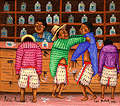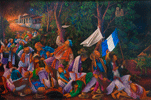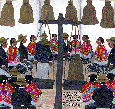| . | |
| . | |
 |
|
| . | |
| [Note: This Interview appeared in an shortened form in the March/April issue of Cultural Exploring Magazine (P.O. Box 920183, Norcross, GA 30010-0183) and is used with their permission. It is included in its entirety because it tells much about our history and who we are. Ed.] | |
| . | |
| CLICK ON IMAGE FOR LARGER SIZE |
1. Have you studied Mayan art and what
motivated you to study this native culture and for how long have you been working at it? When
I was at the University of Michigan, I studied art history. I was especially interested in
non-western art which at that time consisted in the art of Japan, China, India and the
Middle East. Latin America was covered with the pyramids and brief mention of artists such
as Diego Rivera. Although the courses at that time neglected Latin American art, it was
this study especially of the far eastern art, which made me sure that the Mayan art
of Guatemala was important. In 1985 I visited Guatemala for the first time, and I returned
on a yearly basis. In 1987 I met a sculptor in San Pedro, Vicente Cumes Pop, and
commissioned him to do two wood carvings for me. I paid him for them, but months past and
he did not send them to me as promised. I gave up on them. When I returned to San Pedro a
year later just by chance I passed a house where he was sitting out front putting the
finishing touches on the second one. Vicente told me that San Pedro had a number of oil
painters, and he would introduce me if I wanted. I firmly said no, thinking I would feel
obliged to buy a bad painting from each artist I met. When I left San Pedro I got on a bus
|
| .. | |
| 2. What do the paintings of the Mayan
Tz'utuhil art represent and why do you feel it is an important style to introduce to the
USA? The paintings of the Tz’utuhil Mayan artists represent all aspects of their daily lives, both ceremonial and secular, both present and past. As the Mayan people enter the twentieth century, the world of computers and television, many of their traditions are disappearing or threatened. These paintings visually document those traditions. Some of the subjects painted by artists are not traditions they know of personally, but traditions which they have been told of by their parents and grand parents. The themes include: making tortillas, the masked dances, processions of the religious cofradías, childbirth, weaving, the healing of broken bones by Shaman healers, flying kites, picking coffee and bananas, and pulling a bus out of the mud. Accompanying with the renewed interest in preserving the environment and the plant and animal diversity, there is a great interest in the remaining native cultures of this world. The Mayan Indians of Guatemala and southern Mexico are among the largest and most important. Although the Mayan Indians were defeated by the Spaniards they never surrendered. They adapted themselves to this new situation preserving their cultural heritage in whatever ways possible. Their painting is important because it an art form, albeit of recent origin, of an ancient Indian culture which has survived to the present. The Mayans may have borrowed the technique of painting in oil, but the style of this art came from within their own culture with little influence from western schools of art. It is a style entirely unique in the world of art. |
|
| . | |
| 3. How many artists do you have
participating from San Pedro La Laguna and is this a village of artists? Out of the hundreds of Mayan towns and villages in Guatemala until recently only four towns had significant numbers of oil painters: San Juan Comalapa, a Kaqchikel speaking town, and three Tz’utuhil speaking towns on the south side of Lake Atitlán—Santiago Atitlán, San Pedro la Laguna, and San Juan la Laguna. It is with the Tz’utuhil speaking artist mainly from San Pedro and San Juan that Arte Maya Tz’utuhil works. Out of a population of about 10,000 in San Pedro about 40 are oil painters, and out of about 3,000 in San Juan perhaps 20. |
|
| . | |
| 4. How do you arrange these paintings in an
exhibit? Since 1990 Arte Mayan Tz’utuhil has put on more than 25 exhibits of Tz’utuhil Mayan art. Since 1994 we have had a continuous presence on the web where we have hundreds of paintings on view along with biographies of the artists, photographs of the artists, their families, and the surrounding countryside both present and how it was in 1940, and information on the textile traditions of the Katchiquel and Tz’utuhil towns on Lake Atitlán. Every year we have one or more exhibits of paintings for sale, usually featuring one or two artists. We also try to have an exhibit at a small art museum (last year it was the Museo Chicano in Phoenix). The museum shows are examples of some of the best paintings. They include paintings by about twenty artists. These paintings try to show the range of subject matter and styles of the different artists. We are currently arranging an exhibition at the Galería de Casa Latina at the University of California at Santa Cruz which looks like it will probably happen in November. |
|
| . | |
| 5. What are some of the techniques that the
painters utilize and are they demonstrating new styles or is this an old form? All the paintings are oil on canvas. In San Pedro and San Juan they paint almost entirely with brushes. The first painter in San Pedro, Rafael Gonzalez y Gonzalez started painting in 1929 by mixing aniline dyes with the sap of a local tree and made a brush from his own thick hair. Some of his children and grandchildren also became artists and as they progressed and taught others a local style was emerged. Of the Mayan painting styles in Guatemala the Tz’utuhil painters have the most colorful one. |
|
| . | |
| 6. How do North Americans respond to this
art and what have some of their reactions been? Besides their cultural content, the paintings are very detailed and colorful. Everywhere we exhibit them people stop and look, the shows always cause significant comment. Several of the small museums where they have been exhibited have said they are among the very best shows they have ever had. My favorite reactions are from the children. Kids love it. The paintings are easy to respond to, and as a result children become involved. They feel: Hey, maybe I could paint something about my life. It makes art accessible. Over 6,000 school children saw our exhibit when it toured three museums in Michigan. |
|
| . | |
| 7. How many artists are you working with and
how can their work be purchased? Two years ago I was buying all the paintings of four artists, but one died and another one who had worked with me for 6 years left to go on his own, and so now I work with closely with only two artists. When I was in Guatemala in November, the artist who decided not to work with me, spotted me in the street and told me that he was afraid he had made a bad mistake, that his life had been more difficult. That gave me some satisfaction knowing that I had always treated him very nice, and that the possibility of working together again existed. I know he did his very best work when he worked with me, because he was given the freedom to express himself and was not tied to what might be easily saleable. Besides these four artists I work more loosely with about twenty more artists. Every time I go to Guatemala I try to visit all the artists in San Juan and San Pedro, just to maintain contact and see what how their art is progressing. I have interviewed most of them. This November UNESCO came out with a book about the self taught Mayan artists of Guatemala, called "Arte Naif, Guatemala." I think this book marks the beginning of the artists getting the recognition they deserve. Jacques Chirac, the president of France, and Rigoberta Menchú hosted a reception and exhibition for the eighty artists represented in this book. The paintings can be seen in many galleries in Guatemala either in Guatemala City or the towns where the artists paint. Here in the United States the paintings can be seen on our website: www.artemaya.com. There is a section where paintings can be purchased online. |
|
| . | |
| 8. How were you able to obtain these
paintings and please elaborate on the situations that were putting the artists at risk? I go to Guatemala about once a year and buy the best paintings I can. Vicente Cumes, the sculptor who introduced me to many of the artists, acts as a go-between when I am not there by buying paintings from the artists for me. With Vicente handling some of the money I can be assured that when an emergency comes up, such as a sickness in the family of one of the artists, that there will be money immediately available to help. Between 1980 and 1985 there were incredible atrocities done mostly by the military to
the Mayan population. This violence continued on a lesser scale
until the peace accord was signed two years ago. At the army base in Santiago Atitlán in
1990 the Guatemalan army opened fire on Mayan residents protesting an incident and
thirteen Mayans killed, the youngest being ten years old. Even though it would put himself
and his family at risk for their lives artist Pedro Rafael Gonzalez Chavajay decided do a
painting of the massacre. I visited him two weeks after the massacre and while I was there
he secretly painted a small painting about the violence, but there was no way he could
paint a large one in secret. His house was to open. I felt it was very important that he
paint this painting, a subject few other artists would touch at this time, and so in 1993
I brought him to the United States to finish this painting. He brought with him a large
canvas with the church and trees painted in and with the figures sketched in. He had been
telling people that it was a procession. Since the peace accord has been signed other
artists have painted such subjects, but |
|
| . | |
| 9. Is the artist's style unique to region or
does it carry over into different regions as well? Because there is almost no
exchange between the artists of San Juan Comalapa Above: a miniature (5" X 6") painting by Rosa Elena Curruchiche, granddaughter of San Juan Comalapa's first painter Andres Curruchich. Left: This portrait (2.5' x 3' )is painted mostly with spatulas by Juan Francisco Sisay, son of Santiago Atitlán's first painter Juan Sisay. Above previous (question 8) The large painting (3' x 5') of the massacre painted only with fine brushes is by Pedro Rafael Gonzalez Chavajay, grandson of San Pedro's first painter Rafael Gonzalez y Gonzalez. |
|
| . | |
| 10. Is there any intention to offer any
economic assistance in bringing these artists to art schools to further develop their art
? Although Arte Maya Tz’utuhil provides economic and other assistance to the artists, we have no intention of bringing the artists to art schools. All of the artists have started off being self taught or taught other local artists. Their style is something that has come out of and is part and parcel of their culture. The style of their art is unique in this world. One of the most gifted of the young artists from San Juan la Laguna went to art school in Guatemala City. His professors didn’t understand who he was, or the cultural importance of his art. After three years of schooling his style has become a mishmash of Mayan life and European influences. He was a master of the Tz’utuhil school of painting. As a European style artist he is no better than third rate. He no longer has a unique vision or cultural identity in his art. We try to encourage the artists we work closely with to learn on their own and follow their own inspiration. Arte Maya Tz’utuhil has always tried to assist the artists, their families, and the community in the best way possible. Around 70% of our income goes back to the artists, either in the form of money or in the form of art supplies. As an example money from the sale of one important painting was used as a loan to help build a Spanish school in San Pedro (which employs about seven people) before being used to buy land and house-building materials for the artist. We have sent pencils and computers to the public school in San Juan la Laguna where Pedro Rafael Gonzalez works as a teacher. They sent us back photographs taken in the school yard of the two hundred grade school children holding up their three new pencils, and the children were clearly very excited to have their new pencils. What school child in the United States would be excited to be given three new pencils? |
|
| . | |
| . | |
|
To contact us write: Arte Maya Tz'utuhil, P.O. Box 40391, San
Francisco, CA 94140. Telephone: (415) 282-7654.
Email me at
All paintings and photographs Copyright © 1988–2015 Arte Maya Tz'utuhil |



